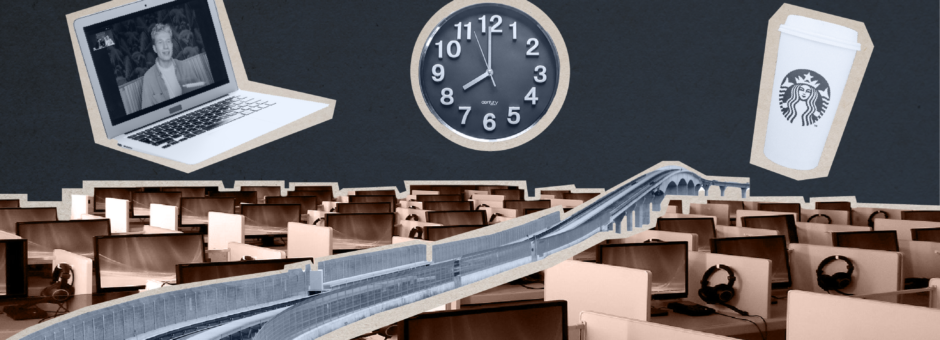Related:
What to Consider Before Ordering Staff Back to the Office
As companies continue to slowly return to the office, they’re asking themselves questions regarding the space itself. Does the pre-pandemic layout still make sense? What role does the office play in our lives? Should we have an office at all? The answers depend on staff attitudes, the labour market, and the individual nature of the company itself. Certain trends have emerged.
Video Conferencing and Flexible Seating Arrangements
“We believe the office is not merely a passive receptacle for modes of work or existing power structures, but an active force of its own, one with the capacity to accelerate change and to support a totally new kind of work and workforce,” writes architect Martin Henn for Bloomberg.1
If the times are a-changing, the thinking goes, the walls we spend our time within ought to change as well.
Those who are in office often find themselves holding video meetings with their co-workers or clients. Many offices are investing in screens, cameras, and microphones to elevate the experience, particularly in conference or meeting rooms.
The prevalence of hybrid work arrangements has also led to more companies instituting so-called hot-desking, whereby workers are foregoing their fixed offices or cubicles in favour of more flexible seating arrangements. Proponents of the arrangement cite space savings. After all, if fewer workers are in the office on a given day, why have all those empty desks taking up room? Silo-busting and increased opportunity for collaboration are also touted as potential benefits.
Critics, on the other hand, can’t get past the inherent chaos. These are the people who long for the days of ‘their office’ and ‘their desk’. Humans are, by nature, territorial.
Hot-Desking, Hoteling, and Neighbourhoods
Not all flexible seating arrangements are created equally, so it’s important to note some key distinctions.
Hot-desking is best described as a first-come-first-served approach to seating. Under this arrangement staff never quite know where they’ll be working. Competition for primo-seating may harken back to the days of the school bus.
Hoteling, on the other hand, makes use of a reservation system. Staff members utilize a booking system to place a hold on a workstation, meeting room, or other section of the office, as needed.
Sometimes all of this shuffling around can have negative consequences, such as an employee trying to concentrate, only to have their proximity invaded by a boisterous brainstorming session. Designating neighbourhoods as loud, quiet, interactive, and so on, can address this.
Wellness, Perks, and ‘Playground-Style Spaces’
Companies have gone to great lengths to entice hesitant workers back to the office. L’Oréal made headlines when they offered concierge services for workers returning to their California-based West Coast Headquarters.2
Physical and mental well-being are top of mind for many people and offices are responding in kind. Everything from yoga rooms to courtyard workspaces are being made available in the name of employee wellness.
While the benefits are obvious, Henn is wary of the campus-style workplaces made famous by Google and other Silicon Valley titans.
“These playground-style spaces, intended to make work a more joyous, more engaging enterprise, have had the perverse effect of staking an undue psychic claim on employees’ time,” he wrote. “Why go home at all, they implied, when you can stay here and keep working?”1
Are Offices Needed at All?
Perhaps the bigger question facing companies is whether to keep an office at all? The temptation to downsize or completely forgo office space is an obvious one. If your staff prefer to work remotely and have demonstrated the ability to do so effectively, then why not save some money by eliminating rent from the equation?
There are those, of course, who believe that such a move would be disastrous for company cohesiveness, and simply refuse to do so. Again, it boils down to the nature of your company, staff, and management style.
Go Hybrid, Shrink the Office
Those who aren’t ready to ditch the office altogether may be inclined to simply employ a hybrid working model and downsize their office accordingly. It makes sense at a glance. If employees are working from home two days per week, it stands to reason that fewer workers will be on site on any given day.
In reality, there are faults with this logic. For starters, given a choice, many workers will opt to work Monday and Friday from home. Offices will be a virtual ghost town on those days, while operating at near capacity Tuesday through Thursday. This, of course, limits the amount of space that can be eliminated.
Furthermore, the current trend is toward less clutter. Even if companies are able to eliminate a substantial number of desks, they may opt to use the space for meeting rooms and other functions, rather than forgo it altogether.
What Office Works Best for Your Business?

Companies will ultimately make their decisions based on what works for them. As long as there is a tight labour market, companies who do operate out of an office will be under pressure to have a nice one. It is, after all, part of your recruiting pitch.
If, on the other hand, a recession forces companies to tighten their purse strings, the temptation to downsize or eliminate offices altogether may grow too strong to ignore.
Ultimately, as work evolves, so too do work spaces. Companies will continue to search for new ways to work effectively, attract candidates, and save money. For smart companies it’s not a matter of hard and fast rules, but of understanding what it takes to maximize their unique business.




